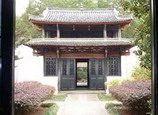
 |
| Zhongshan Gate, which was named Chaoyang Gate during the Ming Dynasty, was rebuilt in 1928, and its single arch replaced by three. (Shanghai Daily/Hege Tollerud) |
Nanjing, capital of China's eastern Jiangsu Province, boasts beautiful scenery - including the Ming Dynasty (1368–1644) city walls, lakes, the Qinhuai River, Zijin Mountain and Qixia Mountain - a rich history and culture. This time, however, I was there to explore the grandeur and history of the walls.
No time was wasted on arriving in Nanjing, the former capital of China on several dynasties. My first sighting of the Ming city wall was on the western side. It was practically a building site, with a lot of construction work taking place just outside the south-western part of the wall; and none too impressive. I'm sure it will look nice when the work is complete.
Preservation and challenges
In the meantime, I hurried on to the next stop - the southern gate, Zhonghua Gate. Now was the time to get impressed! The biggest of the gates, it's a fortress in its own right, with four thick rows of stone gates.
Built between 1366 and 1386, the Zhonghua Gate is one of the few original 13 Ming gates that remain. Some of the vaults that used to serve as accommodation and storage for as many as 3,000 soldiers now house exhibitions and arts and crafts shops, and, of course, souvenirs.
Most city walls are listed structures, so by law they are part of the state-level heritage. In Nanjing, the wall was put on the national protection list in 1988, and a law passed to secure its protection in the 1990s.
"The state has tried to preserve city walls, even during the 'cultural revolution'," said Yao Yuan, an assistant professor at Nanjing University's School of Government.
"Even if the whole city is torn down, the actual wall is protected. Actually, even single bricks are protected, and it is against the law to take any out."
Yao Yuan is a scholar researching public policies around heritage issues, with a number of articles published on the topic, and teaches Urban Heritage Preservation and Urban Governance at Nanjing University.



















![]()
